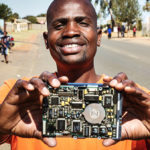Dr. William A. Kennedy knows how having a sick child can burden a family. In the 1970s, his brother suffered from metastatic Ewing’s sarcoma. Getting him the care he needed at a hospital 25 miles away was a full-time job for their mother and required help from other relatives and friends.
Today, Dr. Kennedy, a board-certified pediatric urologist at Lucile Packard Children’s Hospital at Stanford, is using Cisco technology to provide specialty “care-at-a-distance.” The result: children and families don’t need to leave their communities and miss significant time from school and work to receive world-class specialty care.
 Dr. Kennedy with a patient. Photo courtesy Lucile Packard Children’s Hospital.
Dr. Kennedy with a patient. Photo courtesy Lucile Packard Children’s Hospital.
In a blog post today on the Huffington Post, Dr. Kennedy writes that he has been able to reduce wait times for patients by running weekly “telehealth” clinics between Packard Children’s in Palo Alto and Pediatric Group of Monterey, nearly 100 miles to the south. Cisco technology “yields a high-quality clinical interaction that rivals the traditional in-person doctor visit,” Dr. Kennedy writes.
Please read Dr. Kennedy’s full post on the Huffington Post.


This is so important. Problem is that many health care organisations are reticent to have a conversation with their patients. It’s more about health care problem solving rather than a focus on working with the community to challenge health issues together. The high quality interaction happens if there are easy to use interfaces and that the audience feels they can somehow influence change, both in society and in the clinics. That seems to be the sticking point here in Europe. I am surprised at how few clinics have wifi.